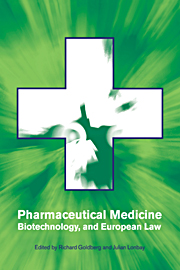Book contents
- Frontmatter
- Contents
- Notes on the contributors
- Preface
- Foreword by Francis G. Jacobs
- Editors' note
- Table of cases
- Table of treaties, European legislative instruments and national legislation
- Introduction
- Part I Free movement of goods and persons, competition and intellectual property
- 1 The free movement of goods I: pharmaceuticals, patents and parallel trade
- 2 The free movement of goods II: pharmaceuticals, trade marks and parallel imports
- 3 The free movement of health care professionals in the European Community
- 4 EC competition law, pharmaceuticals and intellectual property: recent developments
- Part II European drug regulation
- Part III Biotechnology
- Part IV Product liability and transnational health care litigation
- Index
1 - The free movement of goods I: pharmaceuticals, patents and parallel trade
from Part I - Free movement of goods and persons, competition and intellectual property
Published online by Cambridge University Press: 24 October 2009
- Frontmatter
- Contents
- Notes on the contributors
- Preface
- Foreword by Francis G. Jacobs
- Editors' note
- Table of cases
- Table of treaties, European legislative instruments and national legislation
- Introduction
- Part I Free movement of goods and persons, competition and intellectual property
- 1 The free movement of goods I: pharmaceuticals, patents and parallel trade
- 2 The free movement of goods II: pharmaceuticals, trade marks and parallel imports
- 3 The free movement of health care professionals in the European Community
- 4 EC competition law, pharmaceuticals and intellectual property: recent developments
- Part II European drug regulation
- Part III Biotechnology
- Part IV Product liability and transnational health care litigation
- Index
Summary
Parallel importation and intellectual property
This essay is not intended for specialists in intellectual property or European Community law. It is addressed to those who, from time to time, have to wrestle with the baffling issue of when it is legal to employ patents for inventions as a means of resisting ‘parallel importation’, and when as a matter of policy it is desirable to do so. My underlying aim is to set out arguments so that readers can judge for themselves. The arguments vary in relation to the different types of intellectual property – a factor which is often ignored in public debates. The distinctions involved are accordingly my starting point.
Intellectual property rights (IPRs) – patents, copyright, trade marks and so on – exist to prevent those who do not have the rightholder's licence from producing and trading in certain goods or services where otherwise they would be entitled to do so. IPRs indirectly provide their owners with a freedom to trade in a market without direct competition from those with whom they have no connection. Thus composers and record producers have copyrights which they can use to attack pirates who have made illegitimate copies of their music and records; patentees of inventions can prevent their rivals from incorporating the inventive idea into their products, machines and processes.
In essence, IPRs exist on a State-by-State basis and give rights against trading activities within national (or occasionally regional) boundaries. This strict concept of territoriality means that, for instance, patents for a given invention must be obtained for each country.
- Type
- Chapter
- Information
- Pharmaceutical Medicine, Biotechnology and European Law , pp. 11 - 24Publisher: Cambridge University PressPrint publication year: 2001
- 1
- Cited by

